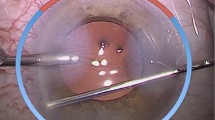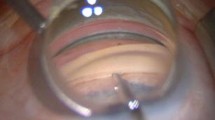Abstract
The main reason for elevation of intraocular pressure in pseudoexfoliation glaucoma is due to secondary plugging of the intertrabecular spaces by pigment and fibrillous material. The aim of the present study was to introduce a new surgical concept to clean trabecular meshwork in pseudoexfoliative glaucoma. ‘Trabecularaspiration’ was performed under the operating microscope prior to extracapsular cataract extraction in half of the chamber angle circumference using a specially designed irrigation-aspiration device. The hand-held instrument has three outlets, one for aspiration (400Μm wide and 45‡ horizontally angulated to meet the slope of the meshwork) and two openings (650Μm) for irrigation to maintain a deep anterior chamber and to keep the iris away from suction. Trabecular debris and pigment was cleared with a suction force of 100–200 mmHg. The effect oftrabecular aspiration was cross-checked by analysing the aspirate. Pigment granules, fibrillous protein and other forms of trabecular debris were identified in the aspirate using light- and scanning electron microscopy. The morphological analysis of the trabecular aspirate clearly indicates the efficacy of‘trabecular aspiration’ for removing pre- and intratrabecular debris. The clinical relevance of this new procedure looks promising, a clinical trial, recently initiated, is warranted.
Similar content being viewed by others
References
Dvorak-Theobald G. Pseudoexfoliation of the lens capsule: relation to true exfoliation of the lens capsule as reported in the literature and role in the production of glaucoma capsulocuticulare. Trans Am Ophthalmol Soc 1953; 51: 385–7.
Morrison JC, Green WR. Light microscopy of the exfoliation syndrom. Acta Ophthalmol 1988; 66 (suppl) 184: 5–27.
Seland JH. The ultrastructural changes in the exfoliation syndrome. Acta Ophthalmol 1988; 66 (suppl) 184: 28–34.
Aasved H. Intraocular pressure in eyes with and without fibrillopathia epitheliocapsularis (so-called senile exfoliation or pseudoexfoliation). Acta Ophthalmol 1971; 49: 601–10.
Vannas A. Vascular changes in pseudoexfoliation of the lens capsule and capsular glaucoma. A fluorescein angiographic study. Greafes Arch Clin Exp Ophthalmol 1972; 184: 248–53.
Aasved HH. The geographical distribution of fibrillopathia epitheliocapsularis, so-called senile exfoliation or pseudoexfoliation of the anterior lens capsule. Acta Ophthalmol 1969; 47: 792–810.
Tarkkanen A. Pseudoexfoliation of the lens capsule. Acta Ophthalmol 1962; 71 (suppl): 126.
Forsius H. Exfoliation syndrome in various ethnic populations, Acta Ophthalmol 1988; 184: 71–85.
Slagsvold JE. The follow-up in patients with pseudoexfoliation of the lens capsule with and without glaucoma. Acta Ophthalmol 1984; 62: 177–82.
Tarkkanen A. Exfoliation syndrome. Trans Ophthalmol Soc UK 1986; 105: 233–6.
Stefaniotou M, Petroutosos G, Psilas K. The frequency of pseudoexfoliation in a region of Greece (Epirus). Acta Ophthalmol 1990; 68: 307–9.
Henry JC, Krupin T, Schmitt M, Lauffer J, Miller E, Ewing MQ, Scheie HG. Long-term follow-up of pseudoexfoliation and the development of elevated intraocular pressure. Ophthalmology 1987; 94: 461–6.
Olivius EOP, Thornburn W. Prognosis of glaucoma simplex and glaucoma capsulare. A comparative study. Acta Ophthalmol 1978; 56: 921–34.
Lindblom B, Thornburn W. Prevalence of visual field defects due to capsular and simple glaucoma in HÄlsingland. Acta Ophthalmol 1982; 60: 353–61.
Sampaolesi R, Zarate J, Croxato O. The chamber angle in exfoliation syndrome. Acta Ophthalmol 1988; 66 (suppl) 184: 48–53.
Klemetti A. Intraocular pressure in exfoliation syndrome. Acta Ophthalmol 1988; 66 (suppl) 184: 54–8.
Yanoff M. Intraocular pressure in exfoliation syndrome. Acta Ophthalmol 1988; 66 (suppl) 184: 59–61.
Kooner KS, Dulaney DD, Zimmerman TJ. Intraocular pressure following ECCE and IOL implantation in patients with glaucoma. Ophthalmic Surg 1988; 19: 570–5.
Steuhl KP, Maharens P, Frohn C, Frohn A. Intraocular pressure and anterior chamber depth after extracapsular cataract extraction with posterior chamber lens implantation. Ophthalmic Surg 1992; 23: 233–7.
Sponagel LD, Gloor B. Ist die Implantation einer Hinterkammerlinse ein drucksenkender Eingriff? Klin Mbl Augenheilk 1986; 188: 495–559.
Payer H, Payer G. Intraokulare Drucksenkung nach Einsetzen von nach hinten gewinkelten ziliarkörpergestützten Sinskey Hinterkammerlinsen in normotonen Augen. Klin Mbl Augenheilk 1983; 183: 381–3.
Diestelhorst M, Krieglstein GK. Der Enflu\der Kataraktextraktion auf die Kammerwasserdynamik bei Patienten bei seniler Katarakt. Fortschr Ophthalmol 1991; 88: 128–31.
Kerstetter JR, Brubaker RF, Wilson SE, Kullerstrand LJ. Prostaglandin F2-1-Isopropylester lowers intraocular pressure without decreasing aqueous humor flow. Am J Ophthalmol 1988; 105: 30–4.
Jerndal T. Open-angle glaucoma and the pseudoexfoliation syndrome. In: Cairns JE (ed) ‘Glaucoma’. Vol II. Grune & Stratton, London, pp 661–677, 1986.
Linner E, Schwanz B, Araujo D. Optic disc pallor and visual field defect in exfoliative and non-exfoliative untreated ocular hypertension. Int Ophthalmol 1989; 13: 21–4.
Quigley HA, Sanchez RM, Dunkelberger GR. Chronic glaucoma selectively damages large optic nerve fibres. Invest Ophthalmol Vis Sci 1987; 28: 913–20.
Anderson DR. Glaucoma: The damage caused by pressure. Am J Ophthalmol 1989; 108: 485–95.
Davanger M, Ringvold A, Blika S. Pseudoexfoliation, IOP and glaucoma. Acta Ophthalmol 1991; 69: 569–73.
Ekström K. Elevated intraocular pressure and pseudoexfoliation of the lens capsule as risk factors for chronic open-angle glaucoma. Acta Ophthalmol 1993; 71: 189–95.
Davanger M. Low-pressure glaucoma and the concept of the IOP tolerance distribution curve. Acta Ophthalmol 1989; 67: 561–4.
Author information
Authors and Affiliations
Rights and permissions
About this article
Cite this article
Jacobi, P.C., Krieglstein, G.K. Trabecular aspiration: a new surgical approach to improve trabecular facility in pseudoexfoliation glaucoma. Int Ophthalmol 18, 153–157 (1994). https://doi.org/10.1007/BF00915964
Accepted:
Issue Date:
DOI: https://doi.org/10.1007/BF00915964




